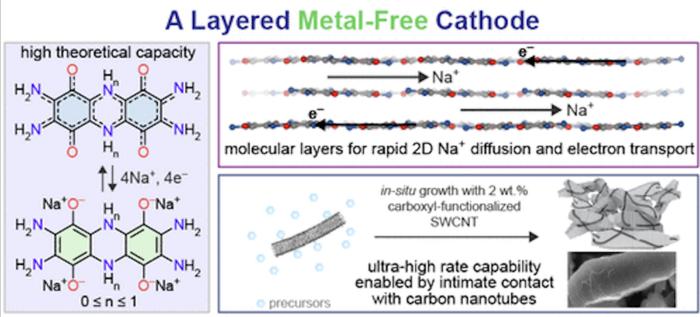
For decades, the reliance on lithium-ion batteries has posed significant challenges in various sectors, including consumer electronics and electric vehicles. As these batteries gained popularity due to their efficiency and rechargeability, scientists recognized the vulnerability associated with lithium sourcing—a process often fraught with geopolitical issues that can disrupt supply chains. In response to these ongoing challenges, researchers have been exploring alternatives that not only minimize dependency on lithium but also enhance battery performance. Recent advancements from Princeton University’s Dincă Group have introduced a promising alternative, utilizing an organic high-energy cathode material for sodium-ion batteries.
Sodium-ion batteries have long been an area of investigation, primarily due to their potential for lower costs and abundant resources. However, these batteries have struggled with low energy density, which limits their effectiveness in applications that demand higher performance. Energy density is critical in determining how long a device can operate on a single charge, making it a key factor for innovations in battery technology. In this milieu, the Dincă Group has made strides in overcoming the limitations of sodium-ion batteries by developing a new cathode material called bis-tetraaminobenzoquinone (TAQ).
The new cathode material offers an impressive fusion of both energy density and power density, outperforming existing lithium-ion technologies. The ability to achieve higher energy density is particularly important in energy-intensive applications, such as electric vehicles and large-scale energy storage systems. With the advent of this organic cathode, the Dincă Group has positioned itself at the forefront of a transition towards safer, economical, and sustainable battery components that can be mass-produced on a commercial scale.
One of the major hurdles that the research team faced while developing sodium-ion batteries was the challenge of achieving both high energy density and high power density simultaneously. Traditionally, optimizing one often detracted from the other. Nonetheless, the Dincă Group’s focus on innovation led them to create a cathode material that effectively circumvents these challenges. This cathode not only displays high energy retention but also enables quick charging—creating the potential for applications that demand both efficiency and performance.
Mircea Dincă, the head of the research team and a prominent figure in the field of chemistry, expressed the significance of diversifying battery materials. He emphasized that sodium is abundant and can be sourced sustainably, particularly from organic matter and seawater. This diversification is critical, especially considering the looming constraints associated with lithium resources. Furthermore, the researchers have demonstrated that the innovative TAQ material can be adapted for large-scale production, addressing the urgent need for sustainable energy storage solutions in our technology-driven world.
The team’s findings are documented in their recent study published in the Journal of the American Chemical Society. The research outlines not just the chemical advantages of TAQ as a cathode but also its environmental benefits. The use of carbon nanotube binders facilitated the seamless combination of TAQ crystals with carbon particles, notably enhancing electron transport and utilization rates within the battery. This architectural innovation results in a nearly theoretical maximum capacity for the sodium-ion battery, a milestone that has eluded many researchers in the field.
TAQ’s stability against environmental factors such as moisture and its endurance at high temperatures further adds to its appeal. Such characteristics are vital for the long-term reliability of batteries, especially in applications that may expose them to less-than-ideal conditions. The durability and effectiveness of this new cathode material suggest a shift towards batteries that not only perform better but also last longer, reducing the need for frequent replacements.
The Dincă Group’s research illuminates potential pathways for the development of new technologies that could transform energy storage systems across various sectors. Their work is particularly pertinent in the context of renewable energy systems, where efficient energy storage is critical for balancing supply and demand. As the global focus shifts towards sustainability and reducing carbon emissions, innovations like those from the Dincă Group will likely play a pivotal role in facilitating the transition towards greener energy solutions.
With their findings and methodologies now available for wider scrutiny and application, the Dincă Group aims to inspire further research into organic materials for battery technology. Such initiatives could lead to breakthroughs in efficiency and accessibility that the world desperately needs. The journey towards more sustainable alternatives has only just begun, but the promising results demonstrated by this group signal a bright future for sodium-ion technology and highlight the importance of interdisciplinary research in tackling global energy issues.
As the conversation around energy storage continues, the insights gained from the Dincă Group’s work will likely influence subsequent studies and innovations. Shared resources, expert collaboration, and transparency among researchers are crucial components for accelerating advancements in battery technology. The implications of this research resonate across multiple disciplines, echoing affirmatively the necessity for a diverse portfolio of materials in addressing today’s and tomorrow’s energy challenges.
In closing, the innovative research demonstrated by Princeton University’s Dincă Group presents compelling evidence that the future of battery technology could reside in organic materials. This signals not just a technological shift, but a paradigm change in how we think about energy storage solutions in a world where sustainability is paramount. The findings underline that electric-powered technologies can evolve, leveraging abundant materials that promise both performance and environmental responsibility, thereby reshaping the landscape of energy storage for years to come.
—
Subject of Research: Sodium-ion battery technology
Article Title: High-Energy, High-Power Sodium-Ion Batteries from a Layered Organic Cathode
News Publication Date: February 4, 2025
Web References: Journal of the American Chemical Society
References: None provided
Image Credits: Graphic by the Dinca Lab
Keywords
sodium-ion batteries, organic cathode, energy density, power density, sustainable technology, lithium alternatives, Dinca Group, battery research, renewable energy storage, environmental sustainability
Tags: alternatives to lithium-ion batteriesbis-tetraaminobenzoquinone cathodebreakthroughs in energy storage solutionsconsumer electronics battery technologyDincă Group innovationselectric vehicle battery performanceenergy density in battery technologyorganic high-energy cathode materialsPrinceton University battery researchsodium-ion battery advancementssupply chain issues in battery productionsustainable battery solutions





